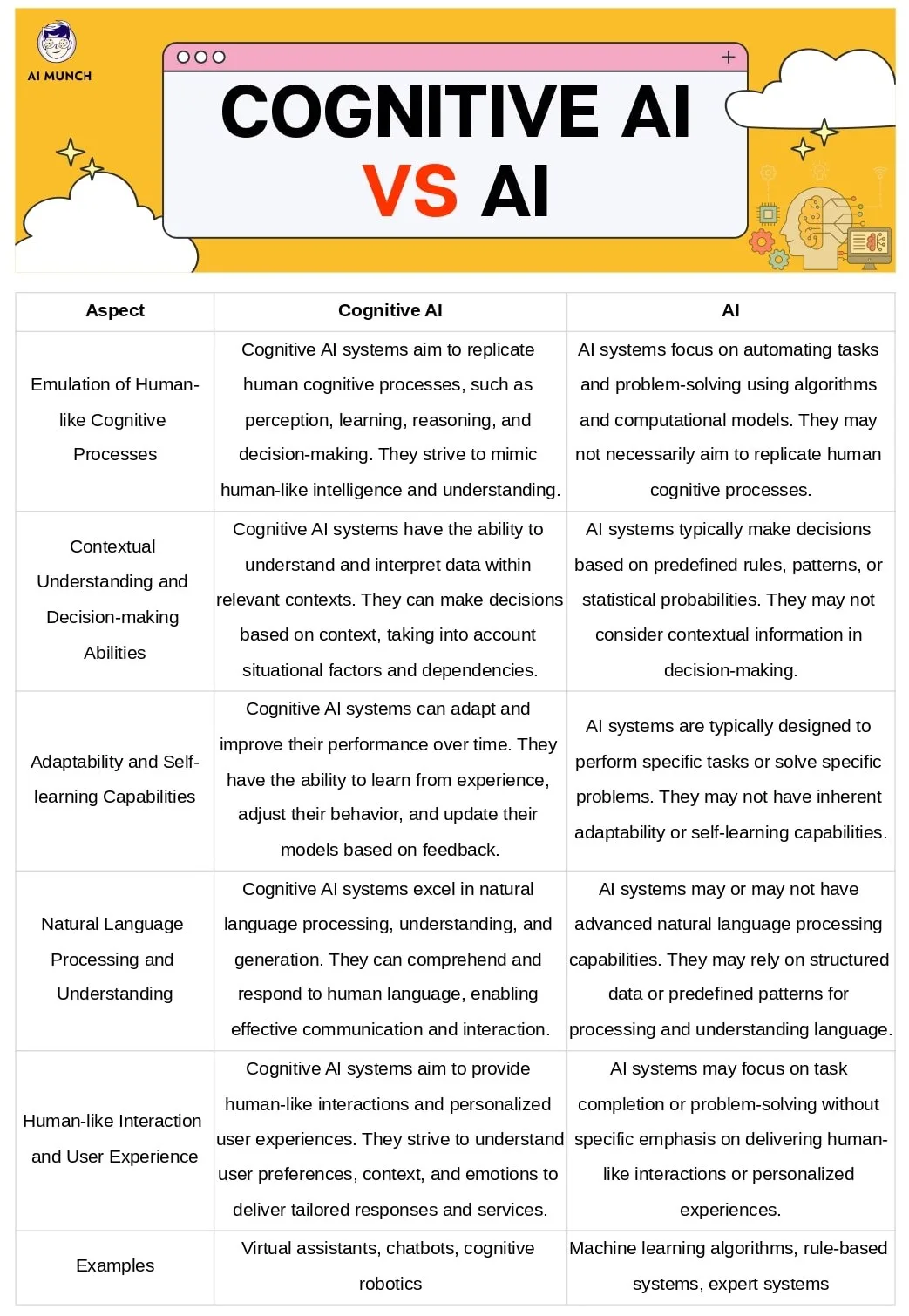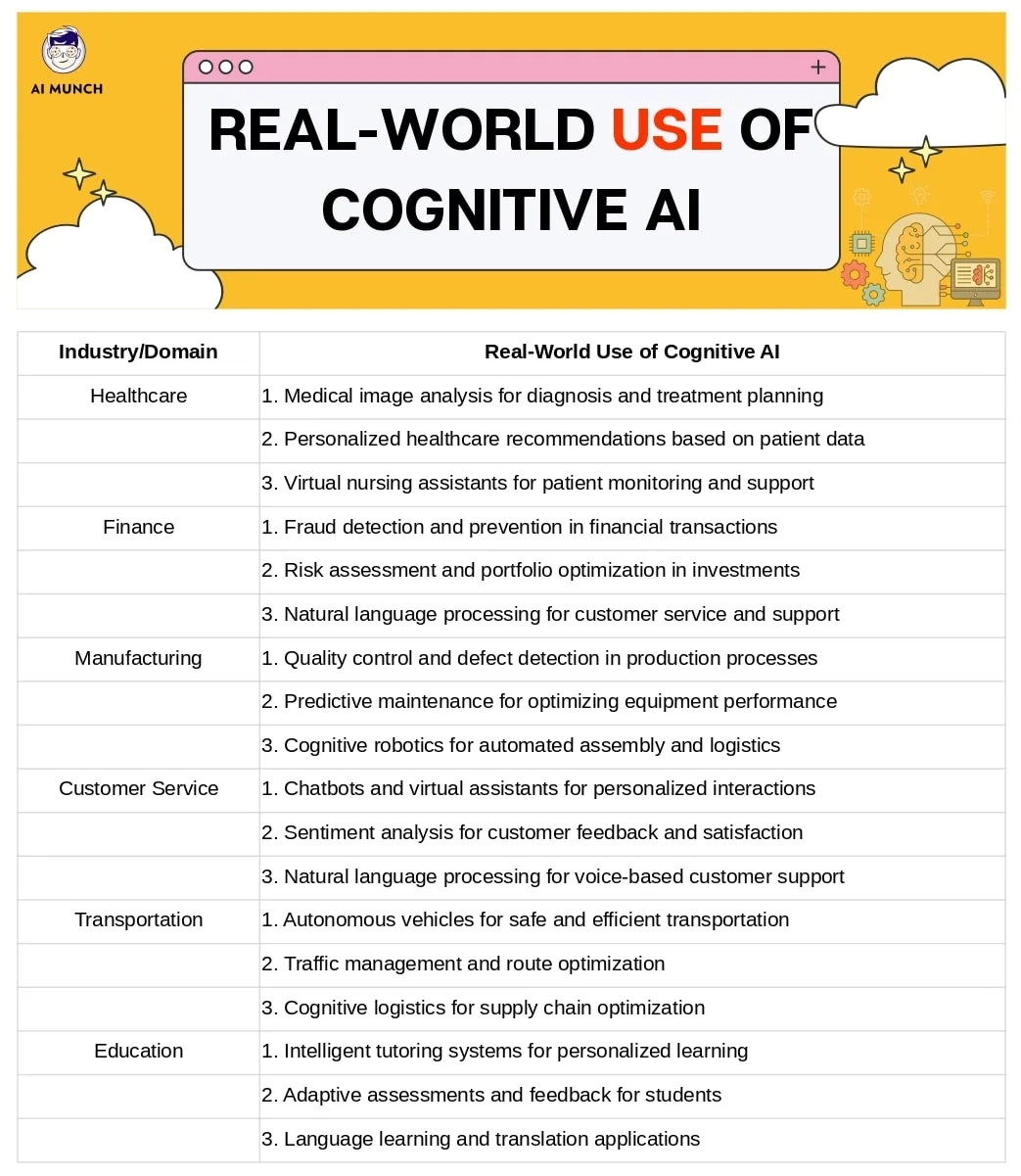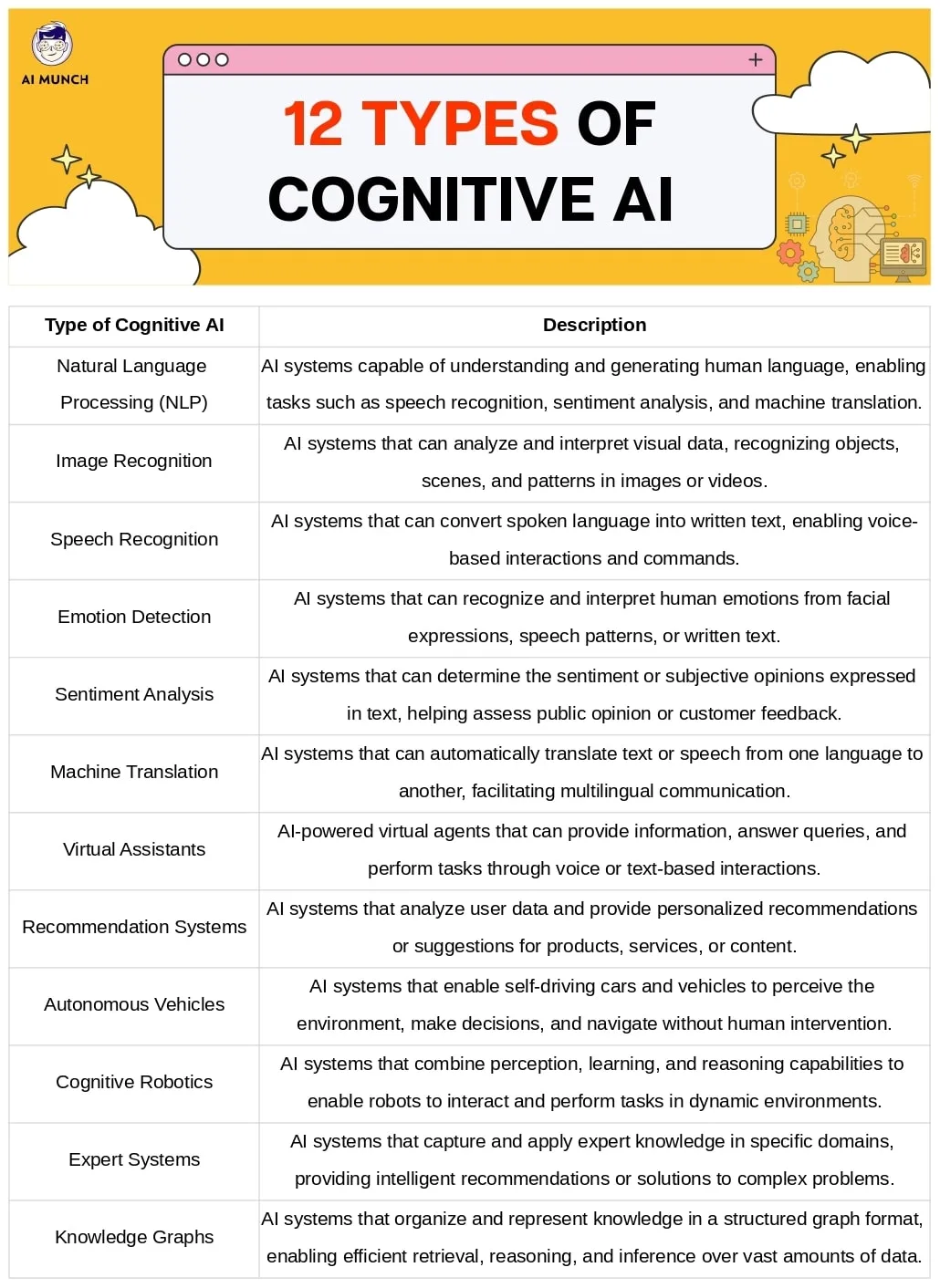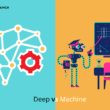Table of Contents Show
I. Introduction
Cognitive artificial intelligence, also known as cognitive AI, refers to a branch of artificial intelligence that aims to create intelligent systems capable of emulating human-like cognitive processes. It encompasses the ability to perceive, reason, learn, and interact with the environment in a manner similar to how humans do. One question that arises here is, can AI have cognitive abilities?
Importance and applications of cognitive AI
Cognitive AI holds immense importance in various industries and fields due to its potential to revolutionize decision-making, problem-solving, and automation. By incorporating cognitive abilities into artificial intelligence systems, organizations can enhance customer experiences, optimize business operations, and unlock new opportunities for innovation. Cognitive AI finds applications in areas such as healthcare, finance, customer service, manufacturing, transportation, and more.
A brief overview of the article’s structure
This article aims to provide a comprehensive understanding of cognitive AI, exploring its definitions, distinctions from traditional AI, and real-world applications. It will delve into the key differentiators that set cognitive AI apart, including its emulation of human-like cognitive processes, contextual understanding and decision-making abilities, as well as its adaptability and self-learning capabilities. The article will also touch upon cognitive computing as a prime example of cognitive artificial intelligence, showcase exemplary applications of cognitive AI, discuss cognitive learning, explore different types of cognitive artificial intelligence systems, and conclude with a reflection on the transformative potential of cognitive artificial intelligence.
II. Cognitive AI vs AI: Unraveling the Distinctions
A. Definition and capabilities of traditional AI
Traditional AI refers to systems that are designed to perform specific tasks or solve well-defined problems by following predefined rules and algorithms. These systems excel in tasks that require processing large amounts of data and performing repetitive operations. Traditional AI primarily relies on machine learning techniques, such as supervised and unsupervised learning, to make predictions and classifications.
B. Key differentiators of cognitive AI
- Emulation of human-like cognitive processes
Cognitive AI aims to mimic human cognitive abilities, including perception, reasoning, learning, and problem-solving. Unlike traditional artificial intelligence, which focuses on narrow and task-specific objectives, cognitive artificial intelligence endeavours to replicate the complexities of human cognition. This enables cognitive artificial intelligence systems to understand and interpret information more holistically and nuancedly. - Contextual understanding and decision-making abilities
Cognitive AI systems possess contextual understanding, allowing them to comprehend and interpret data within the appropriate context. They can analyze unstructured data, such as natural language, images, and videos, and derive meaningful insights. This contextual understanding enables more informed and accurate decision-making, even in ambiguous or complex situations. - Adaptability and self-learning capabilities
One of the key differentiators of cognitive AI is its ability to adapt and learn from experience. Cognitive artificial intelligence systems can continuously refine their performance by learning from data, feedback, and interactions with their environment. Through techniques like reinforcement learning and deep neural networks, cognitive AI systems can improve their capabilities over time, making them more flexible and adaptable to evolving circumstances.
By incorporating these differentiators, cognitive artificial intelligence systems offer enhanced capabilities compared to traditional AI, making them more proficient in handling complex and dynamic real-world scenarios.

III. Cognitive Computing: A Prime Example of Cognitive AI
A. Definition and key components of cognitive computing
Cognitive computing is a subset of cognitive artificial intelligence that focuses on developing systems capable of understanding and interacting with humans in a more natural and intelligent manner. It integrates various technologies, including natural language processing, machine learning, knowledge representation, and reasoning, to emulate human-like cognitive processes. The key components of cognitive computing systems include:
- Data ingestion and preprocessing: Cognitive computing systems gather and preprocess vast amounts of structured and unstructured data from diverse sources, including text, images, videos, and sensor data.
- Natural language processing (NLP): NLP enables systems to understand and process human language, including speech recognition, language understanding, and language generation. It allows for improved human-computer interactions through voice commands, chatbots, and virtual assistants.
- Machine learning and pattern recognition: Cognitive computing leverages machine learning algorithms to identify patterns, extract insights, and make predictions from the data. These algorithms enable the system to learn and adapt based on experiences and improve its performance over time.
- Knowledge representation and reasoning: Cognitive computing systems use knowledge graphs, ontologies, or other structured representations to organize and represent knowledge. They employ reasoning mechanisms to infer new knowledge, make logical deductions, and support complex decision-making.
B. Real-world applications of cognitive computing
- Natural language processing and understanding: Cognitive computing systems excel in understanding and processing natural language, enabling applications such as language translation, sentiment analysis, chatbots, voice assistants, and intelligent search engines.
- Image and pattern recognition: Cognitive computing can analyze and interpret images, videos, and patterns to extract meaningful information. It finds applications in fields like facial recognition, object detection, medical imaging analysis, quality control in manufacturing, and autonomous vehicles.
- Sentiment analysis and emotion detection: Cognitive computing systems can analyze text or audio data to determine sentiment, emotions, and subjective opinions. This has applications in social media monitoring, customer feedback analysis, and market research.
IV. Cognitive AI in Action: Showcasing Exemplary Applications
A. Case study 1: Virtual Assistants and chatbots
Virtual assistants and chatbots are widely used applications of cognitive AI. They leverage natural language processing and understanding to interact with users in a conversational manner. Key features include:
- Natural language processing and generation: Using NLP techniques, virtual assistants can understand and respond to user queries, commands, and requests. They can generate human-like responses to provide relevant and personalized information.
- Contextual understanding and personalized responses: Cognitive AI allows virtual assistants to understand the context of a conversation and provide tailored responses. They can remember previous interactions, learn user preferences, and adapt their responses accordingly.
B. Case study 2: Autonomous vehicles
Autonomous vehicles represent another notable application of cognitive AI. They rely on advanced sensory perception, real-time decision-making, and adaptive navigation. Key elements include:
- Sensory perception and environment analysis: Cognitive AI systems in autonomous vehicles use sensors, such as cameras, lidar, radar, and GPS, to perceive and interpret their surroundings. They can detect objects, recognize road signs, and assess potential hazards.
- Real-time decision-making and adaptive navigation: Cognitive AI algorithms process sensor data and make instant decisions based on complex situational analysis. They can navigate through traffic, choose optimal routes, and adapt to changing road conditions, improving safety and efficiency.
By examining these exemplary applications, we can see how cognitive artificial intelligence enhances various domains by enabling more intuitive and intelligent interactions and decision-making processes.

V. Cognitive Learning: Enhancing Intelligence through Experience
A. Definition and characteristics of cognitive learning
Cognitive learning refers to the process by which AI systems acquire knowledge, improve performance, and enhance their intelligence through experience and interaction with their environment. It involves the ability to perceive patterns, make connections, and adapt behaviour based on feedback and outcomes. Key characteristics of cognitive learning include:
- Adaptability: Cognitive learning allows AI systems to adjust their behaviour and responses based on changing circumstances and new information. They can dynamically update their knowledge and models to improve performance.
- Contextual understanding: Cognitive learning enables AI systems to understand and interpret data within relevant contexts. They can identify meaningful patterns, relationships, and dependencies, making predictions and decisions more accurate.
- Continuous improvement: Cognitive learning is an iterative process where AI systems learn from feedback, identify areas for improvement, and refine their models and algorithms over time. They can leverage techniques like reinforcement learning to optimize performance.
B. Real-life examples of cognitive learning
- Personalized recommendations in streaming platforms: Streaming platforms, such as Netflix and Spotify, utilize cognitive learning to provide personalized recommendations to users. These systems analyze user preferences, viewing history, and behavior patterns to understand individual tastes and interests. By continuously learning from user interactions and feedback, the platforms suggest content tailored to each user’s preferences, enhancing the overall user experience.
- Fraud detection systems in financial institutions: Cognitive learning plays a crucial role in fraud detection systems used by financial institutions. These systems analyze vast amounts of transaction data and learn patterns associated with fraudulent activities. By leveraging machine learning algorithms, they can identify anomalies, detect suspicious behavior, and adapt their detection techniques to evolving fraud patterns, thus helping protect financial institutions and their customers.
VI. Exploring Different Types of Cognitive AI Systems
A. Rule-based systems: Rule-based systems use a set of predefined rules and logic to make decisions and solve problems. They are often used in expert systems, where domain-specific knowledge is encoded into rules, allowing the system to reason and provide solutions based on those rules.
B. Neural networks and deep learning models: Neural networks are a type of cognitive AI system inspired by the structure and function of the human brain. Deep learning models, which are based on neural networks, utilize multiple layers of interconnected nodes to learn and extract features from data. They are highly effective in tasks such as image recognition, natural language processing, and speech recognition.
C. Bayesian networks and probabilistic reasoning: Bayesian networks are cognitive AI systems that represent and reason with uncertain and probabilistic information. They model the relationships between variables using probability distributions and can infer probabilities and make predictions based on observed evidence.
D. Expert systems and knowledge-based systems: Expert systems are cognitive AI systems designed to mimic the decision-making capabilities of human experts in specific domains. They rely on a knowledge base, which contains expert knowledge and rules, to solve complex problems and provide expert-level advice. Knowledge-based systems incorporate a broader range of knowledge representation and reasoning techniques to support complex cognitive tasks.
By exploring these different types of cognitive AI systems, we gain insight into the diverse approaches used to enhance intelligent behavior, decision-making, and problem-solving. Each type has its own strengths and applications, contributing to the overall landscape of cognitive AI.

VII. The 4 Basic Cognitive Concepts in AI
A. Perception and sensing: Cognitive AI systems rely on perception and sensing to gather data from the environment. This involves using sensors, such as cameras, microphones, or other input devices, to capture and interpret information. Perception enables AI systems to understand and make sense of the world around them, including recognizing objects, understanding speech, and interpreting sensory inputs.
B. Learning and knowledge representation: cognitive artificial intelligence systems possess the ability to learn from data and represent knowledge. Learning involves acquiring new information, identifying patterns, and updating models based on experience. Knowledge representation refers to how AI systems store and organize acquired knowledge, using structured representations such as knowledge graphs, ontologies, or semantic networks. These concepts enable AI systems to leverage acquired knowledge for reasoning and decision-making.
C. Reasoning and decision-making: cognitive artificial intelligence systems employ reasoning to draw conclusions, make inferences, and solve problems. They use logical and probabilistic reasoning techniques to process information, assess different possibilities, and make informed decisions based on available evidence. Reasoning allows AI systems to think through complex scenarios, evaluate options, and select the most appropriate course of action.
D. Communication and interaction: Cognitive AI systems are designed to communicate and interact with humans and other systems. They utilize natural language processing, generation, and understanding techniques to facilitate effective communication. This enables AI systems to understand and respond to human queries, provide explanations, and engage in meaningful interactions, enhancing their usability and applicability.
VIII. Conclusion: Unleashing the Power of Cognitive AI
In this article, we explored the concept of cognitive artificial intelligence and its distinctions from traditional AI. We examined cognitive computing as a prime example of cognitive AI and highlighted its real-world applications, such as natural language processing, image recognition, and sentiment analysis. Additionally, we showcased exemplary applications of cognitive AI, including virtual assistants and chatbots, as well as autonomous vehicles. We discussed cognitive learning and its real-life examples, such as personalized recommendations in streaming platforms and fraud detection systems in financial institutions. Furthermore, we explored different types of cognitive artificial intelligence systems, including rule-based systems, neural networks, Bayesian networks, and expert systems. Finally, we examined the four basic cognitive concepts in AI: perception and sensing, learning and knowledge representation, reasoning and decision-making, and communication and interaction.
A. Potential future advancements and challenges in cognitive AI:
As cognitive artificial intelligence continues to evolve, we can expect advancements in areas such as deep learning, natural language understanding, and contextual reasoning. However, challenges remain, including ethical considerations, data privacy, and ensuring transparency and accountability in AI decision-making. Addressing these challenges will be crucial in harnessing the full potential of cognitive AI.
B. Closing thoughts on the transformative impact of cognitive AI on various industries:
Cognitive AI has the potential to revolutionize numerous industries, including healthcare, finance, manufacturing, customer service, and transportation. Its ability to emulate human-like cognitive processes, understand complex data, and make informed decisions opens up opportunities for improved efficiency, personalized experiences, and enhanced decision-making. The transformative impact of cognitive artificial intelligence is expected to reshape industries, empower human-AI collaboration, and drive innovation in the years to come.
Do you want to read more? Check out these articles.








